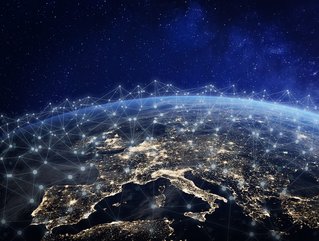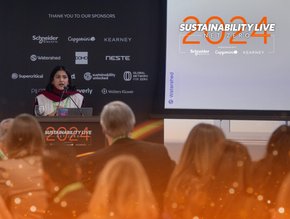Inmarsat – driving sustainability through connectivity

CSO hears from Inmarsat’s Director of Energy Innovation Gary Bray on how the global satellite communications giant is supporting energy companies with their sustainability goals.
Enjoying its 40th anniversary year, Inmarsat is the world’s leading global mobile satellite communication services provider. “We deliver reliable satellite, voice and high-speed data communications for governments and enterprises with a range of services that can be used on land, sea and in the air,” confirms Inmarsat’s Director of Energy Innovation Gary Bray.
With decades of experience to draw on, how can Inmarsat’s connectivity solutions help support the sustainability goals of enterprises on a global scale? Bray notes the energy sector is under a great deal of pressure from governments, consumers and activists to reduce non-renewable energy consumption and minimise any negative impact on our environment. This is putting significant pressure on organisations to comply with new regulatory guidelines, which in turn places revenues and profits under severe strain.
“Energy businesses are increasingly seeing Industrial IoT as a core element for improving both their sustainability and their environmental footprint,” says Bray. “Research from Inmarsat Enterprise, which surveyed 125 global energy businesses, revealed that 60% are aiming to use IoT to improve the efficiency of how they use resources, and over half (54%) are hoping to improve their monitoring of environmental changes.”
Bray believes an area where IoT can significantly improve the environmental footprint of the energy sector is pipeline monitoring. “There can be multiple reasons for pipeline leaks but corrosion of materials, construction defects and cracking have been cited as the leading causes of incidents,” he warns. “Connected Industrial IoT sensors can monitor pipelines in real-time by analysing structural integrity, pressure values and flow rates, alerting management if there are any anomalies or issues so they can be resolved much faster. Quicker resolution reduces the impact on profits of leaked oil and gas, as well as the cost of environmental rehabilitation.”
Industrial IoT will be essential for any energy company to truly improve sustainability and CSR whilst also bolstering health and safety of the entire workforce maintains Bray: “Collecting accurate, real-time data from pipelines, environments and workers, which often run through areas of limited mobile coverage, can be a real challenge for energy businesses if they do not have a reliable, global connectivity solution in place. To guarantee they have constant visibility over their infrastructure, energy businesses must ensure that they have integrated satellite connectivity into their IoT communications network.”
Inmarsat’s efforts have seen it honoured as a sustainability champion in the international cooperation category of the prestigious World Summit on the Information Society (WSIS) Prizes 2018. Under the UK Space Agency International Partnership Programme (IPP), Inmarsat is currently leading three project that use satellite connectivity to benefit communities in developing and emerging economies. In partnership with governments and regional organisations, the projects tackle challenges in healthcare, sustainable fishing, and disaster response.
In Nigeria, land-based telecoms are not only expensive to deploy, there are also difficulties with maintaining power to systems and security issues. Using satellite connectivity, Inmarsat is enabling eHealth data and telemedicine information to be available in clinics in the north and south of the country, where isolated and poor communities have little access to medical care and advice. Working in partnership with NGOs, its BGAN service is enabling the use of training videos and information systems, to improve healthcare management.
Inmarsat is also addressing the digital divide in within the fisheries community of Indonesia to keep workers connected. From a compliance standpoint, governments cannot track the catch and consumers don’t know if the fish they are buying are from a sustainable source and have been caught legally. Working with the Indonesian Ministry of Marine Affairs (KKP) Inmarsat is implementing smart satellite technology to reduce illegal and unsustainable fishing and improve the safety and livelihood of the seven-million strong fishing community.
SEE ALSO:
-
ADNOC wins award for Best CSR Program in Education
-
Kinect Energy: How CSR initiatives can have a transformative impact on indigenous populations
-
Cisco releases 2018 CSR report, aims to focus on emissions and waste reduction
- Read the latest edition of CSO Magazine, here
Meanwhile in the Philippines, Inmarsat is enabling connectivity to support communities hit by natural disasters, including hurricanes, typhoons and tsunamis. “It’s a core part of our business strategy,” pledges Bray. One of the most intense typhoons on record, Super Typhoon Yolanda, hit the Philippines in November 2013, severely damaging electricity and telco infrastructure, blocking access to critical information.
“Working with a consortium of partners, Inmarsat helped to deliver vital communications for emergency responders on the ground and the wider communities, by using advanced satellite communications technology,” recalls Bray. “This enabled us to provide the Philippine government with a step-change in capability, restoring normal life and business infrastructure as quickly as possible. Inmarsat’s LX service allows anyone on the ground to easily connect to a powerful, reliable global KA band network through any portable or mobile device with true broadband speeds. Even when all local networks have been disrupted or destroyed, this enables instant high bandwidth communication between responders, departments and anyone in need of assistance.”
Looking to the future, automation is a key Industry 4.0 trend across sectors further enabled by Inmarsat’s IoT solutions. “Our customers are demanding visibility over their entire operations, from exploration to extraction through to processing and distribution,” reveals Bray. “IoT-connected sensors can give energy businesses this visibility, providing mission-critical data to enable much more accurate decision-making in real-time.”
Bray highlights the exploration phase, where sensors embedded in the ground can provide drilling companies with detailed seismic data to help them build 3D maps of deposits with much greater speed, accelerating the decision-making cycle and helping energy businesses drill with improved accuracy. In turn, this use of IoT can reduce exploration costs which can be crucial to maintaining a competitive edge and keeping a business sustainable.
“A communications network that can reliably and consistently transmit data from anywhere on the planet is critical to the success of IoT solutions. Energy infrastructure and installations are often in remote regions not covered by terrestrial communication networks, so energy companies need to integrate global satellite connectivity,” advises Bray.
“We are working with some of the world’s largest energy companies to develop deployments of IoT technology that demonstrate the value that connected sensors and data analysis can bring,” concludes Bray. “Our managed IoT service will enable these companies to connect anything to anything, deploying sensors to monitor pipeline pressure or fluid levels in machinery, collecting data and transferring it through software-defined gateways across robust communication networks to cloud platforms for analysis. This approach to IoT gives our customers in the energy sector access to all the data they need to automate and optimise their operations, improve their sustainability and protect their profit margins.”






